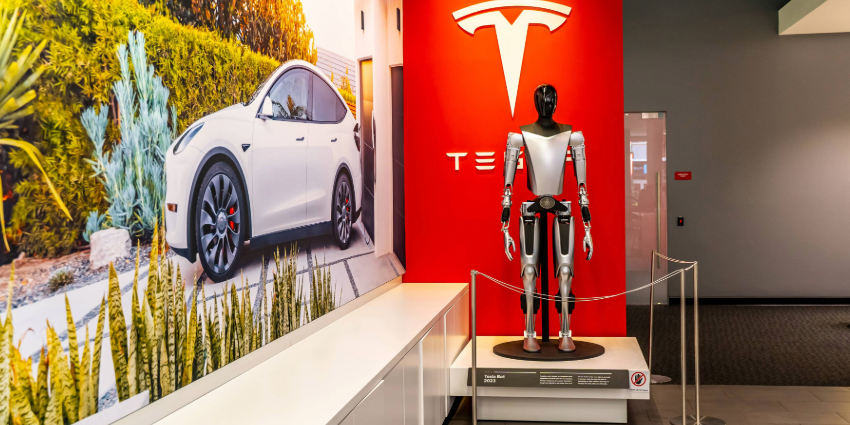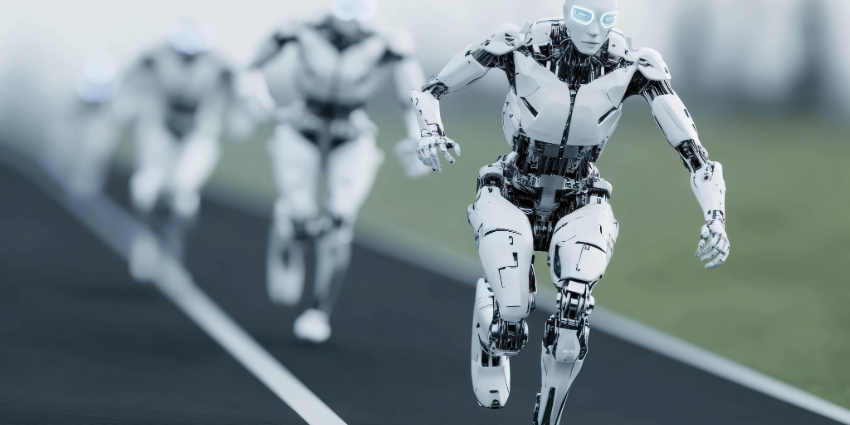Humanoid robots aren’t really a new idea. Our parents (and grandparents) grew up reading books featuring sci-fi visions of mechanical men – but few of us actually expected to see these bots in our homes – or workplaces. Now, things are changing.
Figure, one of the world leaders in the robotics landscape, unveiled its BotQ factory in March 2025 – built to mass-produce tens of thousands of humanoid robots each year. The company isn’t just ramping up production either – its Figure bots are already making their way into businesses – supporting manufacturing leaders like BMW.
Figure isn’t the only one making waves either – Tesla’s promising to produce several thousand “affordable” Optimus humanoid robots in 2025. Google Deepmind is diving into a new “Gemini Robotics” program – and Meta’s also jumping on the robot roundabout.
All the while, analysts like Gartner are starting to predict about 10% of all smart robots sold by 2027 will be humanoids. Goldman Sachs even foresees a $6 billion market emerging in the next 10-15 years – allowing humanoid bots to fill about 4% of the US manufacturing labor shortage by 2030.
So, are humanoid robots closer than we think?
The I, Robot Revolution: A Seismic Shift
Looking back, this isn’t the first time innovators have tried to embed humanoid robots into the workplace. Way back in the 1960s, SRI International unveiled “Shakey” – not really a humanoid by today’s standards – but still with arms and “eyes.” Honda’s ASIMO – a robot that looked like a child dressed up in a spacesuit – hit the scene in the 2000s – running and jumping (just like a person).
But in the last couple of decades – a lot has changed. Technology has started evolving much faster than it once did – revolutions in generative and agentic AI are enough to prove that.
We’ve stepped into a new era where sensor costs are plummeting (and becoming more advanced, with the rise of LiDAR tech). That means manufacturers can create bots that can interact more effectively with their environments – like Tesla’s Optimus which can perform virtually infinite tasks, or the KIME bot from Macco Robotics that can recognize human faces.
Then, there are huge AI advancements to think about. Reinforcement learning is allowing robots to reason, generative AI is helping them respond dynamically to new tasks, and “networked learning” is allowing for wide-scale, rapid growth. Plus, as Figure’s new factory proves – vendors clearly have more of the resources they need to actually produce humanoid robots at scale.
The Challenges: Why We’re Not There Yet
It seems like we’re on the cusp of a robotic revolution – but as always, there are hurdles. Goldman Sachs, and many others have confirmed this, noting that there are still issues with product design, affordability, and even public acceptance to overcome.
Sure, humanoid robots now have more potential to be commercially viable – but vendors still need to figure out the puzzles of:
Manufacturing: Creating Robots Still Isn’t Simple
Let’s say you want to build an army of humanoid robots. No problem, right? Buy some motors, slap on a few sensors, load up an AI model, and done. Not exactly. These devices must gracefully balance on two legs, sense and interpret their surroundings, talk with humans, climb stairs, open doors, and maybe fetch you a coffee without accidentally causing a disaster.
Figure and Tesla claim they’ve got this problem covered – but they’re still only planning on producing 10s of thousands of models. Compare that to the millions of smartphones produced each year, and you’ll see why widespread adoption still isn’t fully “on the cards”.
Then there’s the issue of actually integrating these bots into workplaces – Most factories are set up for humans or simpler industrial robots, which typically sit in a cage doing one repetitive task. A humanoid is far more flexible but also a bigger puzzle piece to fit into existing workflows. An early approach many manufacturers take is to limit the robots to small, specific tasks, run pilot programs, gather data, and only then expand.
Plus, while battery and actuator tech is improving, most humanoid robots today can only realistically operate for a few hours before they run out of juice – limiting their potential.
Affordability: The Cost of Robotic Workers
Companies like Tesla might be promising to make humanoid robots more affordable to the masses ($20,000-$30,000) per model – but a lot of market-leading solutions still cost hundreds of thousands of dollars. That’s without considering training, integration, and maintenance expenses.
That being said, we’re also beginning to recognize the long-term value of these multi-functional bots. Imagine you run a warehouse, and you’re desperate for staff to move inventory 20 hours a day. A modern advanced humanoid might cost about half a million in the long term, but that’s far lower than the cost of training, educating, and hiring a team of human workers.
Investment bank Morgan Stanley even estimated that a $50,000 robot could save a user around $500,000 over 20 years (compared to hiring a low-wage worker). If the supply chain matures, then the cost of a humanoid robot could be pennies per hour a few decades from now.
Adoption: Overcoming Resistance
Clearly, the adoption of humanoid robots is happening. Agility’s Robot Digit has supported companies like Ford, Amazon, and, more recently GXO Logistics over the years. Figure has earned early adoption from BMW, as well as a handful of other manufacturers.
In Healthcare, companies like Cera Care in the UK are deploying robots to support vulnerable adults and reduce NHS costs. Then we have countless other more “specific” niche solutions – like Unitree’s ultra-fast, high-precision G1 bot – that could make its way into countless workplaces.
But people are still reluctant. Some employees are resistant to work alongside robots – fearing job displacement (or constant monitoring). Businesses are concerned about the security, safety, and ethical risks involved in using humanoid robots for everyday tasks – particularly as new AI regulations and data security rules start to emerge.
Even if companies can sidestep these worries, find the perfect robot, and encourage adoption among team members, there are still the cost factors mentioned above to think about.
The Realistic Timeline: When Humanoid Robots Be Commonplace?
Here’s the thing, humanoid robots are already here – they’re already making their way into workplaces, and they’re being developed faster than ever before. But that doesn’t mean they’re going to be mainstream tools by the end of the year.
In the next couple of years, we can expect to see more large enterprises adopting these tools, particularly for manufacturing, warehousing, healthcare, and select service industries. In the next 5-10 years, more mid-sized companies might begin deploying humanoids as costs decrease and integration becomes simpler. In 2035 and beyond, we could begin to see more rapid adoption.
If costs keep dropping, and we figure out a way to address safety and performance concerns, then maybe we will end up with humanoid workers in every office and even helpful companions in homes. However, there’s a long way to go.
The Future of Work with Robots
Humanoid robots have undoubtedly come a long way, and they’re closer to the mainstream than they’ve ever been. But it’s very unlikely there’s going to be a sudden “light switch” moment where we walk into an office and see countless desks occupied by humanoids.
We’re still going to need to move through a period of slow and steady evolution – starting with automotive and industrial companies putting humanoids to the test and powering the next wave of innovation (and probably the one after that).
That being said, the race is on, and big players are already investing billions in a future where humanoid robots could one day walk among us. The next couple of years are going to be interesting – so watch this space.







